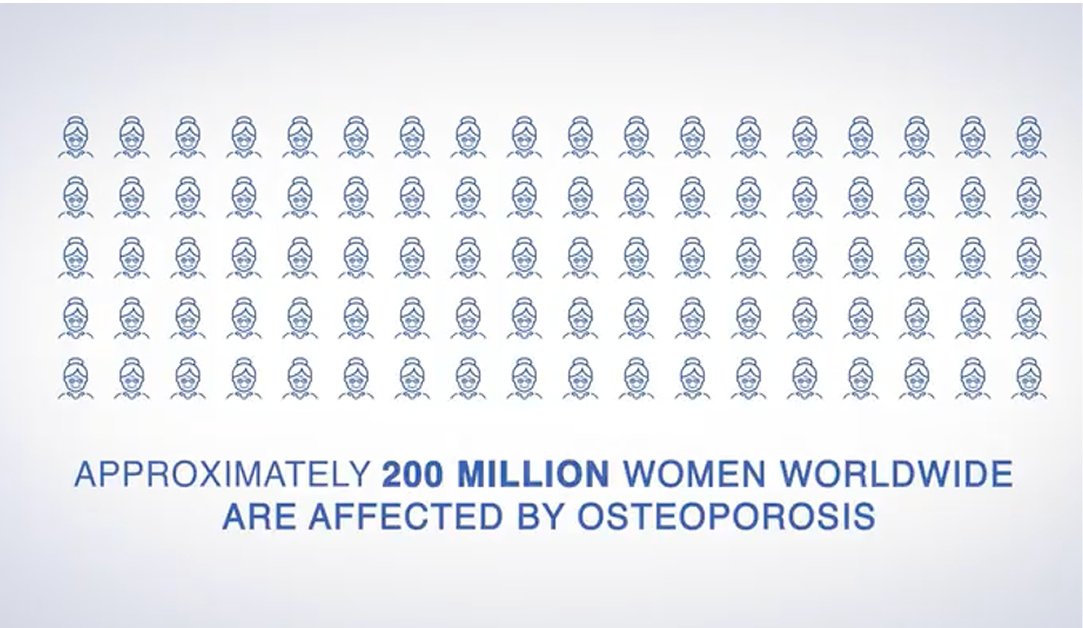

See how your state compares. Explore the geographic pattern of osteoporosis-related fractures for women age ≥ 50 in your area.
Included patients were those with a diagnosis of osteoporosis, a fracture, or treatment for osteoporosis during the study period August 2018–August 2023
Percentages include patients with a fracture, August 2018–August 2022. The patient’s activity was then monitored for 12-months following the most recent fracture, and the number of patients without any services billed from a doctor’s office or stand-alone clinic, outside of a hospital setting, (not only office/clinics that manage osteoporosis care) or a DXA scan during that 12-month follow-up period is reported. Data were calculated as the number of women with a fracture and with no evidence of an office/clinic visit or procedure code for a DXA scan, divided by the number of women with at least one fracture, August 2018–August 2022.
Fractures include patients with one or more medical claims with a diagnosis or procedure code for a fracture during the study period. Fractures were defined as fractures of the hip, femur, pelvis,vertebra, humerus, radius/ulna, tibia/fibula, or clavicle.
Included patients were those with a diagnosis of osteoporosis, a fracture, or treatment for osteoporosis during the study period August 2018–August 2023
Percentages include patients with a fracture, August 2018–August 2022. The patient’s activity was then monitored for 12-months following the most recent fracture, and the number of patients without any services billed from a doctor’s office or stand-alone clinic, outside of a hospital setting, (not only office/clinics that manage osteoporosis care) or a DXA scan during that 12-month follow-up period is reported. Data were calculated as the number of women with a fracture and with no evidence of an office/clinic visit or procedure code for a DXA scan, divided by the number of women with at least one fracture, August 2018–August 2022.
Fractures include patients with one or more medical claims with a diagnosis or procedure code for a fracture during the study period. Fractures were defined as fractures of the hip, femur, pelvis,vertebra, humerus, radius/ulna, tibia/fibula, or clavicle.
No DXA Scan
No DXA Scan
No osteoporosis diagnosis
No osteoporosis diagnosis
No osteoporosis treatment
No osteoporosis treatment
No DXA Scan
No DXA Scan
No osteoporosis diagnosis
No osteoporosis diagnosis
No osteoporosis treatment
No osteoporosis treatment
Contact an Amgen key account manager or medical science liaison in your area to explore the patterns of osteoporosis-related fractures in your institution.
with postmenopausal osteoporosis at high risk for fracture will break a bone in their lifetime3,*

Osteoporosis-related fractures can cause a significant health burden for patients, caregivers, and families.4,5


Hip fractures are associated with a 4x increase in the likelihood of requiring long‑term nursing care4


> 50% of people who experience a hip fracture do not regain their pre-fracture mobility5

from 1.9 million in 2018
to 3.2 million in 2040


from $57 billion in 2018 to
$95 billion in 2040
*Women with high risk of fracture within the Optum Health commercial insurance data (Clinformatics Data Mart [CDMI]) in all 50 states and District of Columbia. 15-18 million annual covered lives for a total of roughly 57 million unique lives over a 13-year period (1/2010–3/2022). Commercial health plan data and Medicare Advantage members were included.3
References: 1. Data on file, Amgen; 2024. 2. Data on file, Amgen; 2024. 3. Data on file, Amgen; 2023. 4. Tajeu GS, Delzell E, Smith W et al. Death, debility, and destitution following hip fracture. J Gerontol A Biol Sci Med Sci. 2014;69:346-353. 5. Yoryuenyong C, Jitpanya C, Sasat S. Factors influencing mobility among people post-surgery for hip fractures: a cross-sectional study. Belitung Nurs J. 2023;9:349-358. 6. Singer A, Exuzides A, Spangler L, et al. Burden of illness for osteoporotic fractures compared with other serious diseases among postmenopausal women in the United States. Mayo Clin Proc. 2015;90:53-62. 7. Lewiecki EM, Ortendahl JD, Vanderpuye-Orgle J, et al. Healthcare policy changes in osteoporosis can improve outcomes and reduce costs in the United States. JBMR Plus. 2019;3:e10192.